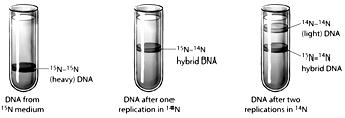Multiple Choice
 Figure 14.1
Figure 14.1
The accompanying figure depicts the result of an experiment to determine how DNA replication occurs. Based on these results, it appears that after replication, each new DNA molecule contains ____.
A) either entirely old DNA strands or entirely new DNA strands
B) one old DNA strand and one new DNA strand
C) entirely new DNA
D) some DNA helix regions from old DNA alternating with some DNA regions from new DNA
E) two strands that are each a mix of old and new DNA
Correct Answer:

Verified
Correct Answer:
Verified
Q40: Individuals with xeroderma pigmentosum inherit a faulty
Q41: In the Meselson-Stahl experiment, bacterial DNA was
Q42: How are purines distinguished from pyrimidines?<br>A) Purines
Q43: When DNA is replicated, _.<br>A) parental histones
Q44: Describe what happens to the nucleosome during
Q46: When Hershey and Chase labeled viruses with
Q47: Classification <br>For the following question(s), identify the
Q48: In DNA, the purines are _.<br>A) thymine
Q49: Nucleic acids are long chains of _.<br>A)
Q50: Without proofreading, the rate of DNA replication